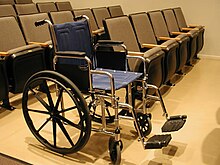Wheelchair


A wheelchair is a mobility device used by people for whom walking is difficult or impossible due to illness or disability.
Basic types:
- Manual. Wheelchairs that are human powered (by the rider). Also known as "self-propelling". Many are designed so that they can also be pushed by another person.
- Electric. Usually powered by a rechargeable battery or batteries. Some are convertible (by removing the motor and changing the wheels) to manual. Other may have a brake release option that offers "freewheeling", allowing the chair to be pushed, much like a manual chair.
- Transport chairs. Wheelchairs that can only be pushed by another person, having all four wheels of equal size, usually approximately 8 inches in diameter, instead of two large wheels in the rear (usually approximately 22–24 inches) and two small 8-inch wheels in the front.
It typically consists of a seat and back supported on two large wheels on two axles attached towards the back of the seat and two small wheels near the feet. However, there are often small additional features to assist mounting curbs or prevent toppling. "Anti-tippers" are rountinely mounted on the back of the chair, (but can be found on the front in some chairs) and prevent the user from overturning the chair.
Wheelchairs come in many sizes and colors and can be highly customized, with several options including seat size (width and depth), seat-to-floor height, footrests/leg rests, cup holder, and much more.
A person moves a manual chair by pushing with their hands, circular bars on the outside of the large wheels, which have a diameter that is slightly less than that of the rear wheels. Also available, one arm drive enables individuals to guide and propel the wheelchair from one side. Two handrims, one smaller than the other, are located on one side of the chair, left or right. On most models the outer, or smaller rim, is connected to the opposite wheel by a folding axle. When both handrims are grasped together, the chair may be propelled forward or backward in a straight line. When either handrim is moved independently, the chair will turn left or right in response to the handrim used.
Powerchairs are moved by actuating motors, usually with a joystick or alternate control for those who do not have hand or arm function (Options include "sip-n-puff" control, chin control, or attendant control).
Experiments have also been made with unusual variant wheels, like the omniwheel or the mecanum wheel. These allow more directional movement options.
Disabled athletes use streamlined sport wheelchairs for sports that require speed and agility, such as basketball, rugby, tennis and racing.

Powerchairs
Powerchairs, or "electric wheelchairs," use electric motors instead of manpower. They are usually powered by rechargeable deep-cycle batteries, similar to those used to power outboard boat engines. The user typically controls speed and direction by operating a joystick similar to that found on video game consoles. Many other input devices can be used if the wheelchair user lacks coordination or dexterity of the hands or fingers or cannot use the hands at all.
Buildings

Adapting the built environment to make it more accessible to wheelchair users is one of the key campaigns of disability rights movements and the Americans with Disabilities Act of 1990 (ADA). For example, the construction of low floor trams and buses is being encouraged whereas the use of paternosters in public buildings without any alternative method of transportation has been criticized due to the lack of access for wheelchair users. Modern street furniture design now incorporates better accessibility for people with disabilities.
Notable users

- Max Cleland, former US Senator from Georgia
- Justin Whitlock Dart, Jr. (1930-2002), disability activist and "father of the Americans with Disabilities Act"
- Ed Roberts, founder of the disability movement
- Julie Fernandez, British actress (see The Office)
- Frank Gardner, BBC journalist who was paralysed after being shot by Al-Qaeda.
- Stephen Hawking, theoretical astrophysicist
- John Hockenberry, American journalist
- Ron Kovic, Vietnam veteran and peace activist
- Jim Langevin, US Congressman from Rhode Island
- Christopher Reeve (1952–2004), late movie actor, the former Superman
- Franklin D. Roosevelt (1882–1945), 32nd President of the United States
- Ahmed Yassin (~1937–2004), assassinated founder of the Hamas organization
Fictional
- Timmy, from South Park
- Joe Swanson, from Family Guy
- Wheels of the Burger King Kids Club Gang
- Ironside
- Andy of Little Britain (doesn't really need it)
- Dr. Strangelove (apparently doesn't need it.)
- Brian Potter from Phoenix Nights
External links
- Dept of Transportation Information about air travelers with disabilities and their rights in the US
- Electric Wheelchair Sports Wheelchair sports for the disabled
- Etiquette: Wheelchair users Suggestions for better communication with people who use wheelchairs
- Kurumaisu Jutsu: Wheelchair Techniques Self defense for wheelchair users
- Grover Gear accessories
- Wheelchairs and Mobility Aids
